Prevention and Management of Pressure Sores in Elderly Patients
VerifiedAdded on 2023/01/18
|18
|4285
|24
Project
AI Summary
This assignment is a comprehensive research proposal addressing the critical issue of pressure sores in hospitalized elderly patients. It begins with an introduction that defines pressure sores, highlights their causes, and emphasizes the importance of preventive care. The study's rationale is based on the high prevalence of pressure sores and their negative impact on patient outcomes. The proposal outlines specific aims and objectives, including identifying causal factors, evaluating preventive measures, and recommending best practices. A literature review provides a conceptual framework and explores relevant theories such as the Health Belief Model and Herzberg's Two-Factor Theory, as well as challenges and gaps in existing research. The methodology section details the research philosophy, approach, design, data collection methods, and ethical considerations. The anticipated outcome is a set of recommendations to improve the prevention and management of pressure sores, ultimately leading to better patient care and reduced mortality rates. The proposal includes a Gantt chart for timeline management.

PREVENTION AND MANAGEMENT OF PRESSURE SORES
AMONG HOSPITALISED ELDERLY PATIENTS
0
AMONG HOSPITALISED ELDERLY PATIENTS
0
Paraphrase This Document
Need a fresh take? Get an instant paraphrase of this document with our AI Paraphraser
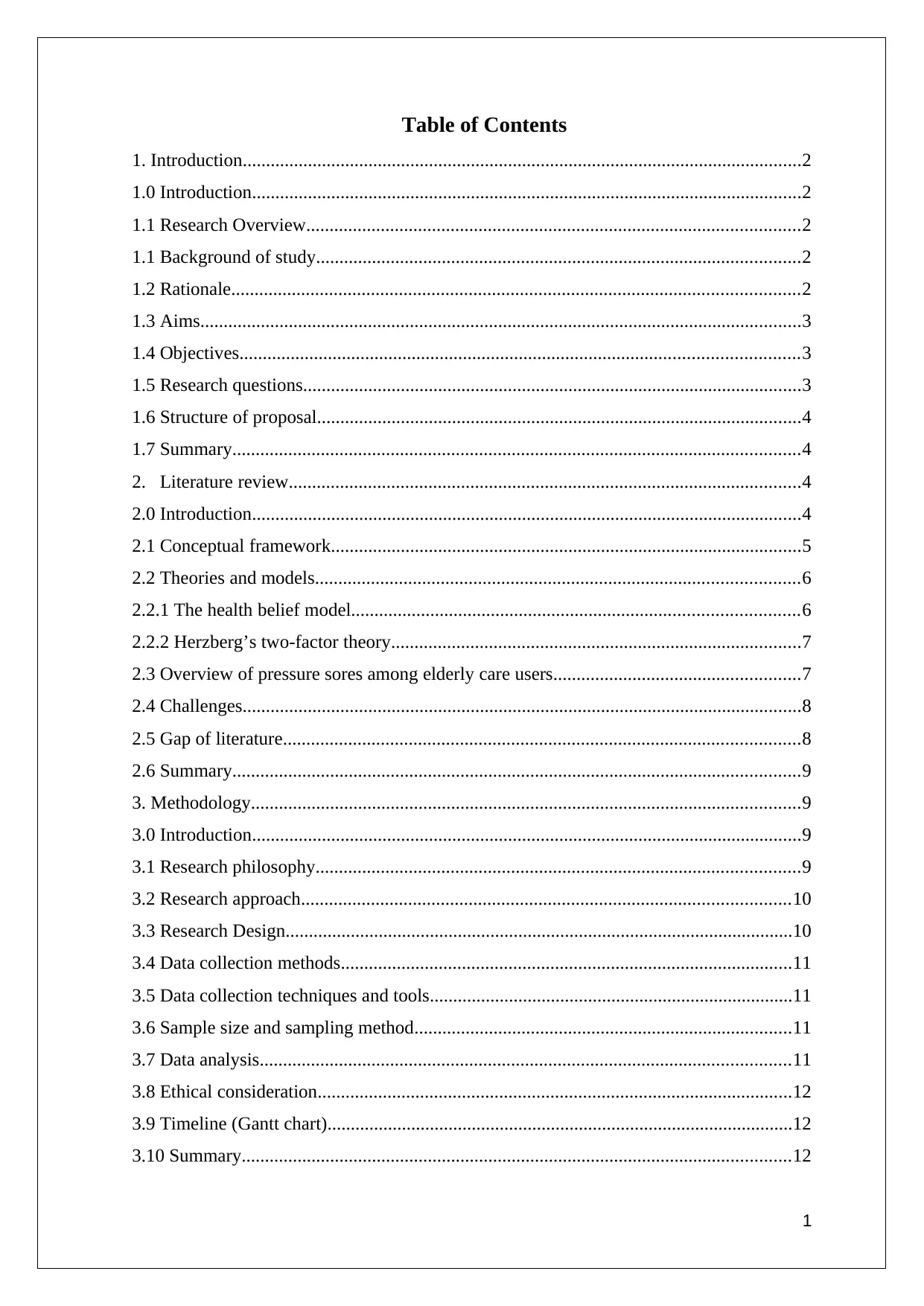
Table of Contents
1. Introduction........................................................................................................................2
1.0 Introduction......................................................................................................................2
1.1 Research Overview..........................................................................................................2
1.1 Background of study........................................................................................................2
1.2 Rationale..........................................................................................................................2
1.3 Aims.................................................................................................................................3
1.4 Objectives........................................................................................................................3
1.5 Research questions...........................................................................................................3
1.6 Structure of proposal........................................................................................................4
1.7 Summary..........................................................................................................................4
2. Literature review..............................................................................................................4
2.0 Introduction......................................................................................................................4
2.1 Conceptual framework.....................................................................................................5
2.2 Theories and models........................................................................................................6
2.2.1 The health belief model................................................................................................6
2.2.2 Herzberg’s two-factor theory........................................................................................7
2.3 Overview of pressure sores among elderly care users.....................................................7
2.4 Challenges........................................................................................................................8
2.5 Gap of literature...............................................................................................................8
2.6 Summary..........................................................................................................................9
3. Methodology......................................................................................................................9
3.0 Introduction......................................................................................................................9
3.1 Research philosophy........................................................................................................9
3.2 Research approach.........................................................................................................10
3.3 Research Design.............................................................................................................10
3.4 Data collection methods.................................................................................................11
3.5 Data collection techniques and tools..............................................................................11
3.6 Sample size and sampling method.................................................................................11
3.7 Data analysis..................................................................................................................11
3.8 Ethical consideration......................................................................................................12
3.9 Timeline (Gantt chart)....................................................................................................12
3.10 Summary......................................................................................................................12
1
1. Introduction........................................................................................................................2
1.0 Introduction......................................................................................................................2
1.1 Research Overview..........................................................................................................2
1.1 Background of study........................................................................................................2
1.2 Rationale..........................................................................................................................2
1.3 Aims.................................................................................................................................3
1.4 Objectives........................................................................................................................3
1.5 Research questions...........................................................................................................3
1.6 Structure of proposal........................................................................................................4
1.7 Summary..........................................................................................................................4
2. Literature review..............................................................................................................4
2.0 Introduction......................................................................................................................4
2.1 Conceptual framework.....................................................................................................5
2.2 Theories and models........................................................................................................6
2.2.1 The health belief model................................................................................................6
2.2.2 Herzberg’s two-factor theory........................................................................................7
2.3 Overview of pressure sores among elderly care users.....................................................7
2.4 Challenges........................................................................................................................8
2.5 Gap of literature...............................................................................................................8
2.6 Summary..........................................................................................................................9
3. Methodology......................................................................................................................9
3.0 Introduction......................................................................................................................9
3.1 Research philosophy........................................................................................................9
3.2 Research approach.........................................................................................................10
3.3 Research Design.............................................................................................................10
3.4 Data collection methods.................................................................................................11
3.5 Data collection techniques and tools..............................................................................11
3.6 Sample size and sampling method.................................................................................11
3.7 Data analysis..................................................................................................................11
3.8 Ethical consideration......................................................................................................12
3.9 Timeline (Gantt chart)....................................................................................................12
3.10 Summary......................................................................................................................12
1
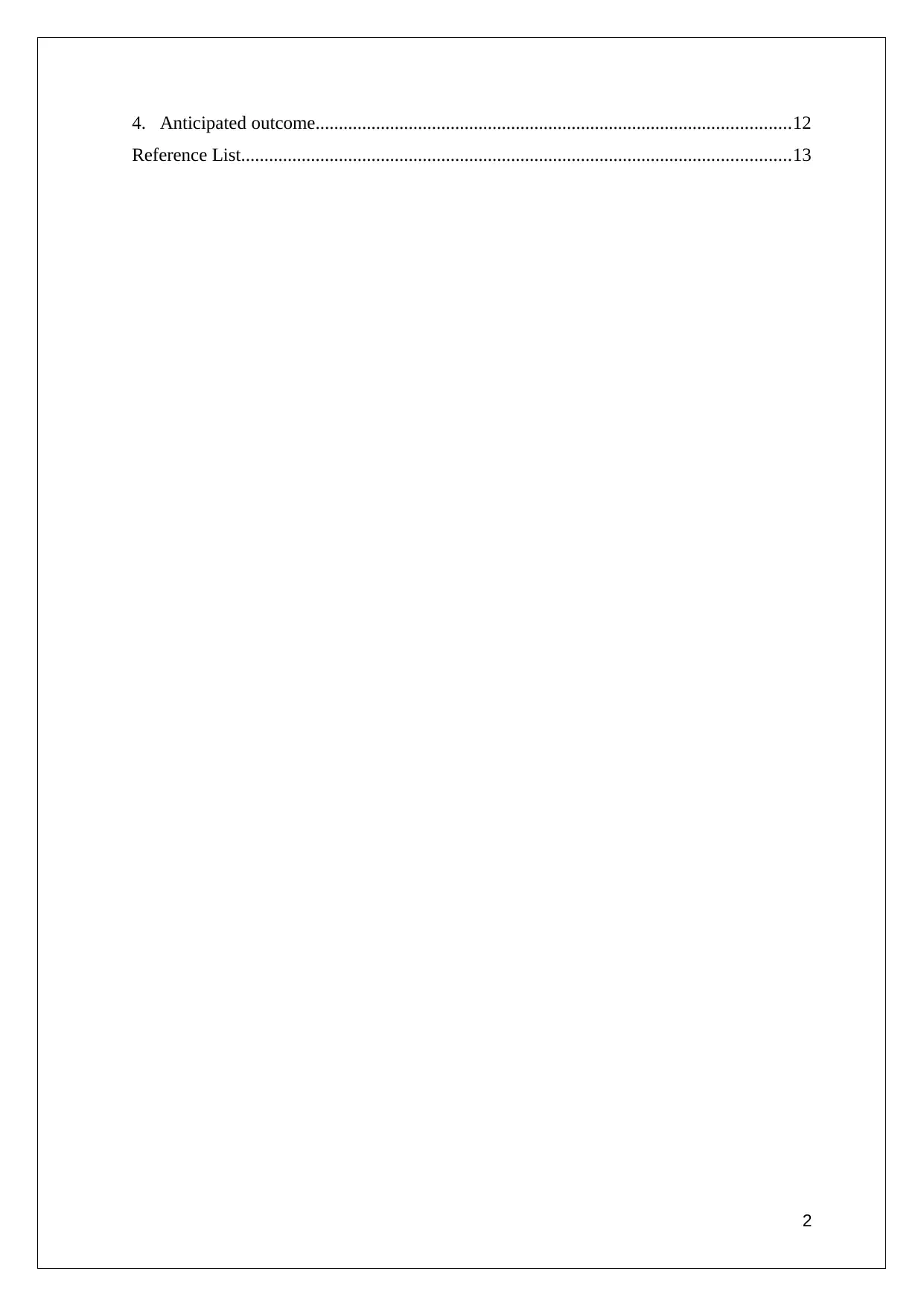
4. Anticipated outcome......................................................................................................12
Reference List......................................................................................................................13
2
Reference List......................................................................................................................13
2
⊘ This is a preview!⊘
Do you want full access?
Subscribe today to unlock all pages.

Trusted by 1+ million students worldwide
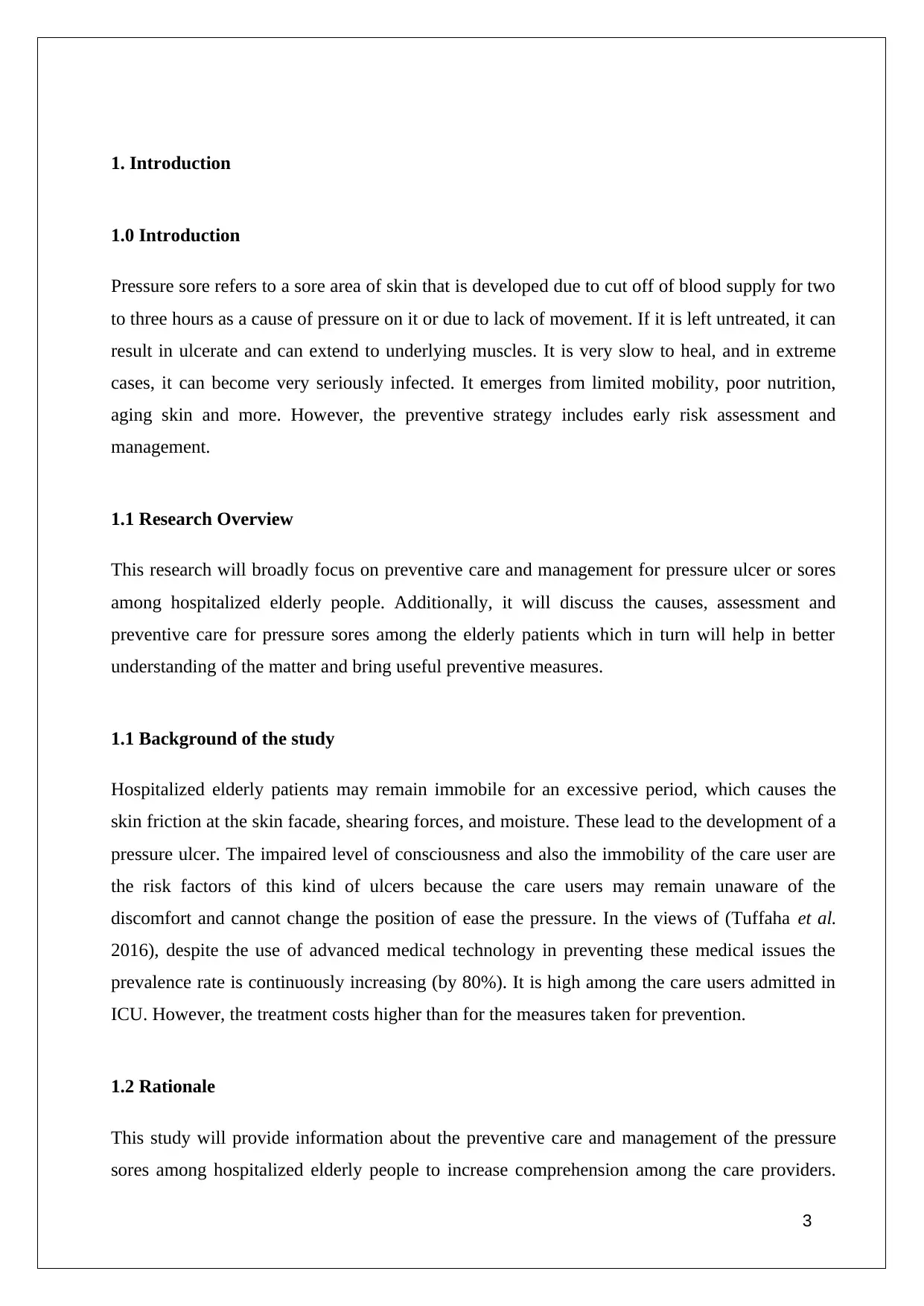
1. Introduction
1.0 Introduction
Pressure sore refers to a sore area of skin that is developed due to cut off of blood supply for two
to three hours as a cause of pressure on it or due to lack of movement. If it is left untreated, it can
result in ulcerate and can extend to underlying muscles. It is very slow to heal, and in extreme
cases, it can become very seriously infected. It emerges from limited mobility, poor nutrition,
aging skin and more. However, the preventive strategy includes early risk assessment and
management.
1.1 Research Overview
This research will broadly focus on preventive care and management for pressure ulcer or sores
among hospitalized elderly people. Additionally, it will discuss the causes, assessment and
preventive care for pressure sores among the elderly patients which in turn will help in better
understanding of the matter and bring useful preventive measures.
1.1 Background of the study
Hospitalized elderly patients may remain immobile for an excessive period, which causes the
skin friction at the skin facade, shearing forces, and moisture. These lead to the development of a
pressure ulcer. The impaired level of consciousness and also the immobility of the care user are
the risk factors of this kind of ulcers because the care users may remain unaware of the
discomfort and cannot change the position of ease the pressure. In the views of (Tuffaha et al.
2016), despite the use of advanced medical technology in preventing these medical issues the
prevalence rate is continuously increasing (by 80%). It is high among the care users admitted in
ICU. However, the treatment costs higher than for the measures taken for prevention.
1.2 Rationale
This study will provide information about the preventive care and management of the pressure
sores among hospitalized elderly people to increase comprehension among the care providers.
3
1.0 Introduction
Pressure sore refers to a sore area of skin that is developed due to cut off of blood supply for two
to three hours as a cause of pressure on it or due to lack of movement. If it is left untreated, it can
result in ulcerate and can extend to underlying muscles. It is very slow to heal, and in extreme
cases, it can become very seriously infected. It emerges from limited mobility, poor nutrition,
aging skin and more. However, the preventive strategy includes early risk assessment and
management.
1.1 Research Overview
This research will broadly focus on preventive care and management for pressure ulcer or sores
among hospitalized elderly people. Additionally, it will discuss the causes, assessment and
preventive care for pressure sores among the elderly patients which in turn will help in better
understanding of the matter and bring useful preventive measures.
1.1 Background of the study
Hospitalized elderly patients may remain immobile for an excessive period, which causes the
skin friction at the skin facade, shearing forces, and moisture. These lead to the development of a
pressure ulcer. The impaired level of consciousness and also the immobility of the care user are
the risk factors of this kind of ulcers because the care users may remain unaware of the
discomfort and cannot change the position of ease the pressure. In the views of (Tuffaha et al.
2016), despite the use of advanced medical technology in preventing these medical issues the
prevalence rate is continuously increasing (by 80%). It is high among the care users admitted in
ICU. However, the treatment costs higher than for the measures taken for prevention.
1.2 Rationale
This study will provide information about the preventive care and management of the pressure
sores among hospitalized elderly people to increase comprehension among the care providers.
3
Paraphrase This Document
Need a fresh take? Get an instant paraphrase of this document with our AI Paraphraser

Often the problem of pressure sores is overlooked as the care users are not always aware of their
problem or in a condition where they can not consciously point out their discomfort (Hahnel et
al. 2017). Due to this cause, prevention or management of the sores are not considered as
important by the care providers. On the other hand, due to lack of attention, the problem
increases and results in a deep infection or ulcer; this may delay the recovery. Therefore, proper
information about preventive care and management for the problems may decrease the rate of
mortality due to a pressure ulcer. Moreover, it will help to prevent the care users suffering from
pain after discharge.
1.3 Aims
This study aims to analyze and evaluate the measures that can prevent and manage the pressure
sores among hospitalized elderly care users.
1.4 Objectives
● To determine the causal factors behind pressure sores among hospitalized elderly care users
● To evaluate the usefulness of the preventive measures used for managing the damage of skin
due to pressure sores among the elderly care users
● To recommend the preventive measures for pressure sores among hospitalized elderly care
users.
1.5 Research questions
● What are the causal factors behind pressure sores among hospitalized elderly care users?
● What is the use of preventive measures that are applied to prevent or manage the pressure
sores among hospitalized elderly care users?
● What are the preventive measures that can be taken into account to prevent and manage
pressure sores among hospitalized elderly care users?
4
problem or in a condition where they can not consciously point out their discomfort (Hahnel et
al. 2017). Due to this cause, prevention or management of the sores are not considered as
important by the care providers. On the other hand, due to lack of attention, the problem
increases and results in a deep infection or ulcer; this may delay the recovery. Therefore, proper
information about preventive care and management for the problems may decrease the rate of
mortality due to a pressure ulcer. Moreover, it will help to prevent the care users suffering from
pain after discharge.
1.3 Aims
This study aims to analyze and evaluate the measures that can prevent and manage the pressure
sores among hospitalized elderly care users.
1.4 Objectives
● To determine the causal factors behind pressure sores among hospitalized elderly care users
● To evaluate the usefulness of the preventive measures used for managing the damage of skin
due to pressure sores among the elderly care users
● To recommend the preventive measures for pressure sores among hospitalized elderly care
users.
1.5 Research questions
● What are the causal factors behind pressure sores among hospitalized elderly care users?
● What is the use of preventive measures that are applied to prevent or manage the pressure
sores among hospitalized elderly care users?
● What are the preventive measures that can be taken into account to prevent and manage
pressure sores among hospitalized elderly care users?
4
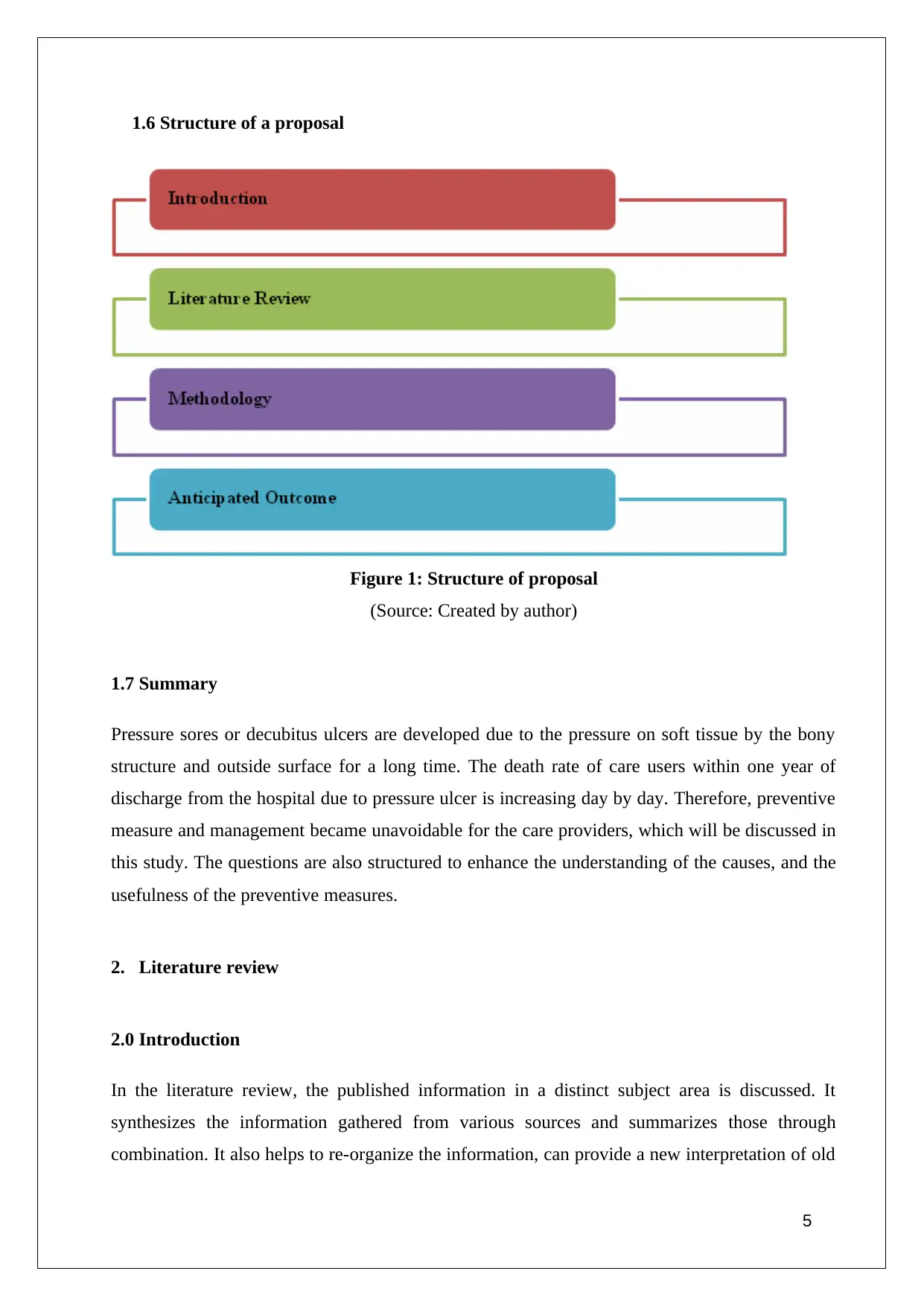
1.6 Structure of a proposal
Figure 1: Structure of proposal
(Source: Created by author)
1.7 Summary
Pressure sores or decubitus ulcers are developed due to the pressure on soft tissue by the bony
structure and outside surface for a long time. The death rate of care users within one year of
discharge from the hospital due to pressure ulcer is increasing day by day. Therefore, preventive
measure and management became unavoidable for the care providers, which will be discussed in
this study. The questions are also structured to enhance the understanding of the causes, and the
usefulness of the preventive measures.
2. Literature review
2.0 Introduction
In the literature review, the published information in a distinct subject area is discussed. It
synthesizes the information gathered from various sources and summarizes those through
combination. It also helps to re-organize the information, can provide a new interpretation of old
5
Figure 1: Structure of proposal
(Source: Created by author)
1.7 Summary
Pressure sores or decubitus ulcers are developed due to the pressure on soft tissue by the bony
structure and outside surface for a long time. The death rate of care users within one year of
discharge from the hospital due to pressure ulcer is increasing day by day. Therefore, preventive
measure and management became unavoidable for the care providers, which will be discussed in
this study. The questions are also structured to enhance the understanding of the causes, and the
usefulness of the preventive measures.
2. Literature review
2.0 Introduction
In the literature review, the published information in a distinct subject area is discussed. It
synthesizes the information gathered from various sources and summarizes those through
combination. It also helps to re-organize the information, can provide a new interpretation of old
5
⊘ This is a preview!⊘
Do you want full access?
Subscribe today to unlock all pages.

Trusted by 1+ million students worldwide
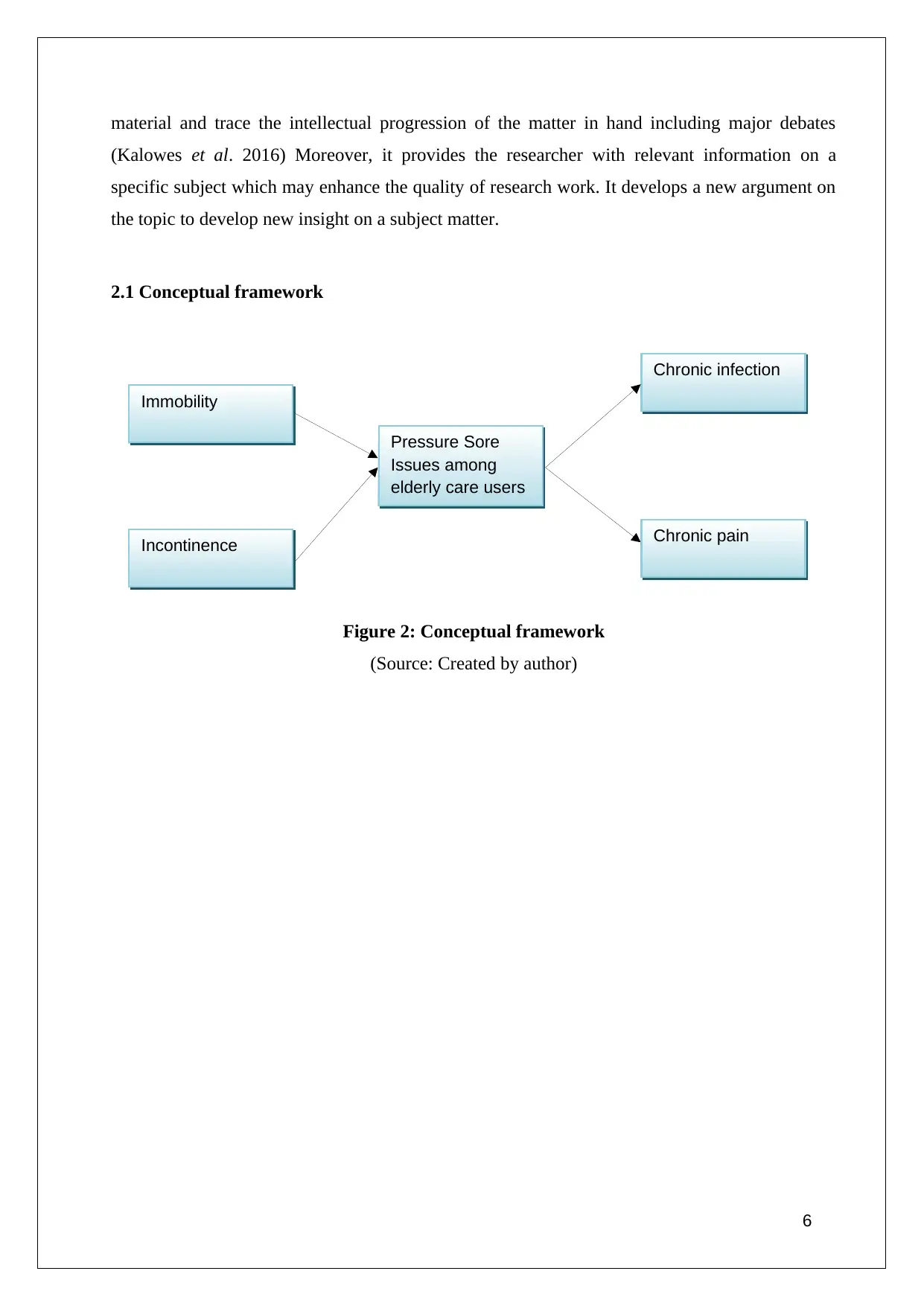
material and trace the intellectual progression of the matter in hand including major debates
(Kalowes et al. 2016) Moreover, it provides the researcher with relevant information on a
specific subject which may enhance the quality of research work. It develops a new argument on
the topic to develop new insight on a subject matter.
2.1 Conceptual framework
Figure 2: Conceptual framework
(Source: Created by author)
6
Immobility
Incontinence Chronic pain
Chronic infection
Pressure Sore
Issues among
elderly care users
(Kalowes et al. 2016) Moreover, it provides the researcher with relevant information on a
specific subject which may enhance the quality of research work. It develops a new argument on
the topic to develop new insight on a subject matter.
2.1 Conceptual framework
Figure 2: Conceptual framework
(Source: Created by author)
6
Immobility
Incontinence Chronic pain
Chronic infection
Pressure Sore
Issues among
elderly care users
Paraphrase This Document
Need a fresh take? Get an instant paraphrase of this document with our AI Paraphraser

2.2 Theories and models
2.2.1 The health belief model
Figure 3: Health Belief Model
(Source: Author)
This is a Psychological model which makes attempts to explain and predict health behaviour
(Xie et al. 2016). There are many Psychological factors that can affect a person’s health care
beliefs. It was developed by social Psychologists Hochbaum, Kegels and Rosenstock in 1950s.
This model believes that if people become aware that the negative effects of a health condition
can be avoided, gives importance to its severity, can perceive the benefits of following the
measures they will promote their health-related behaviours. Moreover, if they believe that they
can successfully follow the recommended behaviour conduct, they will take the health-related
actions.
However, from this model, it can be suggested that if health care providers can perceive the
severity of the problem related to pressure sores and become aware of the prevalence of the
disease, they are likely to take preventive actions against it (Kim et al. 2016). Additionally, they
have to possess the skill of perceiving the barriers such as care user’s individual belief, different
patterns of lifestyle, diversity and more; they can skillfully handle the matter. Moreover, if they
have self-efficacy to take the suggested health care into account such as frequent assessment,
7
2.2.1 The health belief model
Figure 3: Health Belief Model
(Source: Author)
This is a Psychological model which makes attempts to explain and predict health behaviour
(Xie et al. 2016). There are many Psychological factors that can affect a person’s health care
beliefs. It was developed by social Psychologists Hochbaum, Kegels and Rosenstock in 1950s.
This model believes that if people become aware that the negative effects of a health condition
can be avoided, gives importance to its severity, can perceive the benefits of following the
measures they will promote their health-related behaviours. Moreover, if they believe that they
can successfully follow the recommended behaviour conduct, they will take the health-related
actions.
However, from this model, it can be suggested that if health care providers can perceive the
severity of the problem related to pressure sores and become aware of the prevalence of the
disease, they are likely to take preventive actions against it (Kim et al. 2016). Additionally, they
have to possess the skill of perceiving the barriers such as care user’s individual belief, different
patterns of lifestyle, diversity and more; they can skillfully handle the matter. Moreover, if they
have self-efficacy to take the suggested health care into account such as frequent assessment,
7
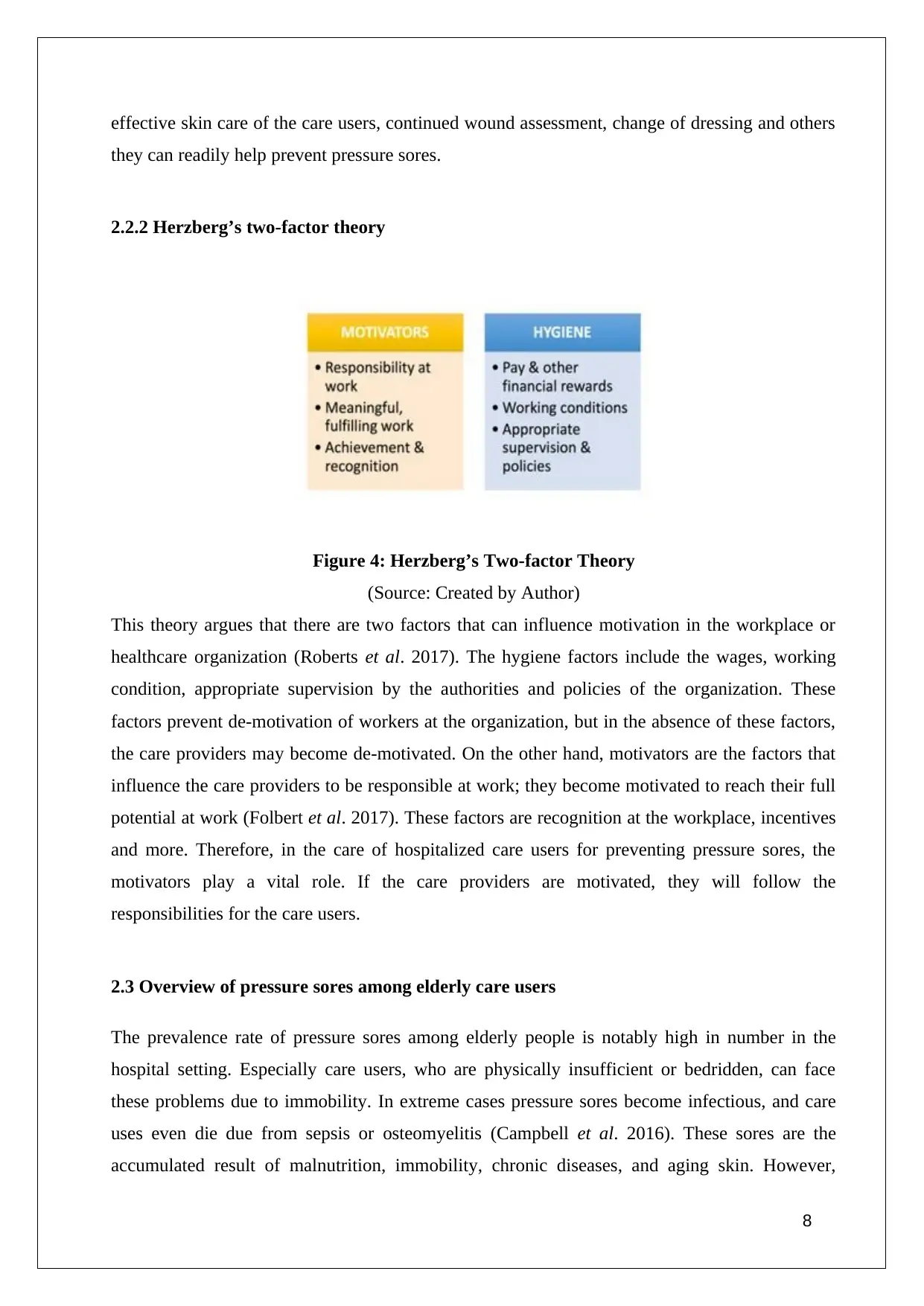
effective skin care of the care users, continued wound assessment, change of dressing and others
they can readily help prevent pressure sores.
2.2.2 Herzberg’s two-factor theory
Figure 4: Herzberg’s Two-factor Theory
(Source: Created by Author)
This theory argues that there are two factors that can influence motivation in the workplace or
healthcare organization (Roberts et al. 2017). The hygiene factors include the wages, working
condition, appropriate supervision by the authorities and policies of the organization. These
factors prevent de-motivation of workers at the organization, but in the absence of these factors,
the care providers may become de-motivated. On the other hand, motivators are the factors that
influence the care providers to be responsible at work; they become motivated to reach their full
potential at work (Folbert et al. 2017). These factors are recognition at the workplace, incentives
and more. Therefore, in the care of hospitalized care users for preventing pressure sores, the
motivators play a vital role. If the care providers are motivated, they will follow the
responsibilities for the care users.
2.3 Overview of pressure sores among elderly care users
The prevalence rate of pressure sores among elderly people is notably high in number in the
hospital setting. Especially care users, who are physically insufficient or bedridden, can face
these problems due to immobility. In extreme cases pressure sores become infectious, and care
uses even die due from sepsis or osteomyelitis (Campbell et al. 2016). These sores are the
accumulated result of malnutrition, immobility, chronic diseases, and aging skin. However,
8
they can readily help prevent pressure sores.
2.2.2 Herzberg’s two-factor theory
Figure 4: Herzberg’s Two-factor Theory
(Source: Created by Author)
This theory argues that there are two factors that can influence motivation in the workplace or
healthcare organization (Roberts et al. 2017). The hygiene factors include the wages, working
condition, appropriate supervision by the authorities and policies of the organization. These
factors prevent de-motivation of workers at the organization, but in the absence of these factors,
the care providers may become de-motivated. On the other hand, motivators are the factors that
influence the care providers to be responsible at work; they become motivated to reach their full
potential at work (Folbert et al. 2017). These factors are recognition at the workplace, incentives
and more. Therefore, in the care of hospitalized care users for preventing pressure sores, the
motivators play a vital role. If the care providers are motivated, they will follow the
responsibilities for the care users.
2.3 Overview of pressure sores among elderly care users
The prevalence rate of pressure sores among elderly people is notably high in number in the
hospital setting. Especially care users, who are physically insufficient or bedridden, can face
these problems due to immobility. In extreme cases pressure sores become infectious, and care
uses even die due from sepsis or osteomyelitis (Campbell et al. 2016). These sores are the
accumulated result of malnutrition, immobility, chronic diseases, and aging skin. However,
8
⊘ This is a preview!⊘
Do you want full access?
Subscribe today to unlock all pages.

Trusted by 1+ million students worldwide
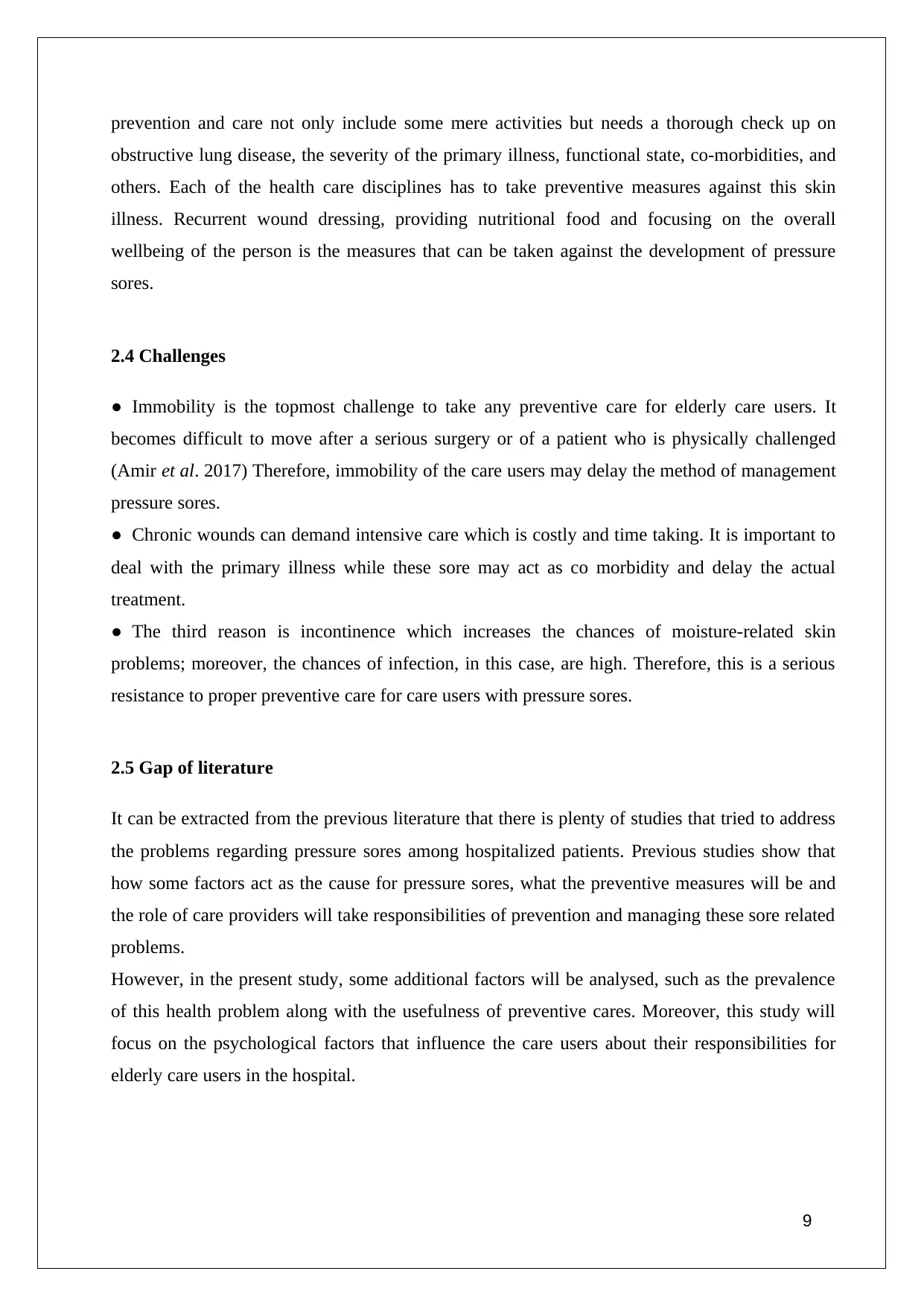
prevention and care not only include some mere activities but needs a thorough check up on
obstructive lung disease, the severity of the primary illness, functional state, co-morbidities, and
others. Each of the health care disciplines has to take preventive measures against this skin
illness. Recurrent wound dressing, providing nutritional food and focusing on the overall
wellbeing of the person is the measures that can be taken against the development of pressure
sores.
2.4 Challenges
● Immobility is the topmost challenge to take any preventive care for elderly care users. It
becomes difficult to move after a serious surgery or of a patient who is physically challenged
(Amir et al. 2017) Therefore, immobility of the care users may delay the method of management
pressure sores.
● Chronic wounds can demand intensive care which is costly and time taking. It is important to
deal with the primary illness while these sore may act as co morbidity and delay the actual
treatment.
● The third reason is incontinence which increases the chances of moisture-related skin
problems; moreover, the chances of infection, in this case, are high. Therefore, this is a serious
resistance to proper preventive care for care users with pressure sores.
2.5 Gap of literature
It can be extracted from the previous literature that there is plenty of studies that tried to address
the problems regarding pressure sores among hospitalized patients. Previous studies show that
how some factors act as the cause for pressure sores, what the preventive measures will be and
the role of care providers will take responsibilities of prevention and managing these sore related
problems.
However, in the present study, some additional factors will be analysed, such as the prevalence
of this health problem along with the usefulness of preventive cares. Moreover, this study will
focus on the psychological factors that influence the care users about their responsibilities for
elderly care users in the hospital.
9
obstructive lung disease, the severity of the primary illness, functional state, co-morbidities, and
others. Each of the health care disciplines has to take preventive measures against this skin
illness. Recurrent wound dressing, providing nutritional food and focusing on the overall
wellbeing of the person is the measures that can be taken against the development of pressure
sores.
2.4 Challenges
● Immobility is the topmost challenge to take any preventive care for elderly care users. It
becomes difficult to move after a serious surgery or of a patient who is physically challenged
(Amir et al. 2017) Therefore, immobility of the care users may delay the method of management
pressure sores.
● Chronic wounds can demand intensive care which is costly and time taking. It is important to
deal with the primary illness while these sore may act as co morbidity and delay the actual
treatment.
● The third reason is incontinence which increases the chances of moisture-related skin
problems; moreover, the chances of infection, in this case, are high. Therefore, this is a serious
resistance to proper preventive care for care users with pressure sores.
2.5 Gap of literature
It can be extracted from the previous literature that there is plenty of studies that tried to address
the problems regarding pressure sores among hospitalized patients. Previous studies show that
how some factors act as the cause for pressure sores, what the preventive measures will be and
the role of care providers will take responsibilities of prevention and managing these sore related
problems.
However, in the present study, some additional factors will be analysed, such as the prevalence
of this health problem along with the usefulness of preventive cares. Moreover, this study will
focus on the psychological factors that influence the care users about their responsibilities for
elderly care users in the hospital.
9
Paraphrase This Document
Need a fresh take? Get an instant paraphrase of this document with our AI Paraphraser

2.6 Summary
In this section, the health belief model is analyzed and it was described how this model
prescribes the self-efficacy and self-confidence to influence the health care providers to maintain
the code of care for care users with the pressure sore problems, additionally, the motivating
factors suggested by Herzberg keeps care providers motivated to take care of the care users.
However, there are some challenges faced by the care providers which may act as a barrier in
health care. Lastly, there are some gaps in the literature are discussed in contrast to the subject
matter of the present study.
3. Methodology
3.0 Introduction
The methodology includes the blueprint of the research; it provides the process by which the
researcher conducts his research to answer the gaps identified in previous literature. There are
plenty of research methodologies which can be used to conduct research (Qaseem et al. 2015).
However, the appropriate method for the intended research should be chosen to get effective
results. It is required to locate the general information about research design and methods
initially. After an adequate search for the methods of the research and evaluation of their
appropriateness, a method is chosen.
3.1 Research philosophy
Positivism indicates that there is a single objective phenomenon in the field of research no matter
what the researcher’s perspective is. Therefore in positivism, a structured approach is
incorporated to conduct research (Walliman, 2017). In this case, there is a clear research topic
identified, and a hypothesis is constructed, and suitable research methodology is chosen, from
this philosophy, a neutral response from the side of sample units may be achieved. Unlike
positivism, the interpretivism believes in multiple realities (Wiescheb et al. 2017). Research
conducted following this philosophy is socially constructed and not objectively determined.
Therefore, interpretivists follow the flexible structural framework. Additionally, they insist on
capturing human interaction to extract their perception of reality.
10
In this section, the health belief model is analyzed and it was described how this model
prescribes the self-efficacy and self-confidence to influence the health care providers to maintain
the code of care for care users with the pressure sore problems, additionally, the motivating
factors suggested by Herzberg keeps care providers motivated to take care of the care users.
However, there are some challenges faced by the care providers which may act as a barrier in
health care. Lastly, there are some gaps in the literature are discussed in contrast to the subject
matter of the present study.
3. Methodology
3.0 Introduction
The methodology includes the blueprint of the research; it provides the process by which the
researcher conducts his research to answer the gaps identified in previous literature. There are
plenty of research methodologies which can be used to conduct research (Qaseem et al. 2015).
However, the appropriate method for the intended research should be chosen to get effective
results. It is required to locate the general information about research design and methods
initially. After an adequate search for the methods of the research and evaluation of their
appropriateness, a method is chosen.
3.1 Research philosophy
Positivism indicates that there is a single objective phenomenon in the field of research no matter
what the researcher’s perspective is. Therefore in positivism, a structured approach is
incorporated to conduct research (Walliman, 2017). In this case, there is a clear research topic
identified, and a hypothesis is constructed, and suitable research methodology is chosen, from
this philosophy, a neutral response from the side of sample units may be achieved. Unlike
positivism, the interpretivism believes in multiple realities (Wiescheb et al. 2017). Research
conducted following this philosophy is socially constructed and not objectively determined.
Therefore, interpretivists follow the flexible structural framework. Additionally, they insist on
capturing human interaction to extract their perception of reality.
10
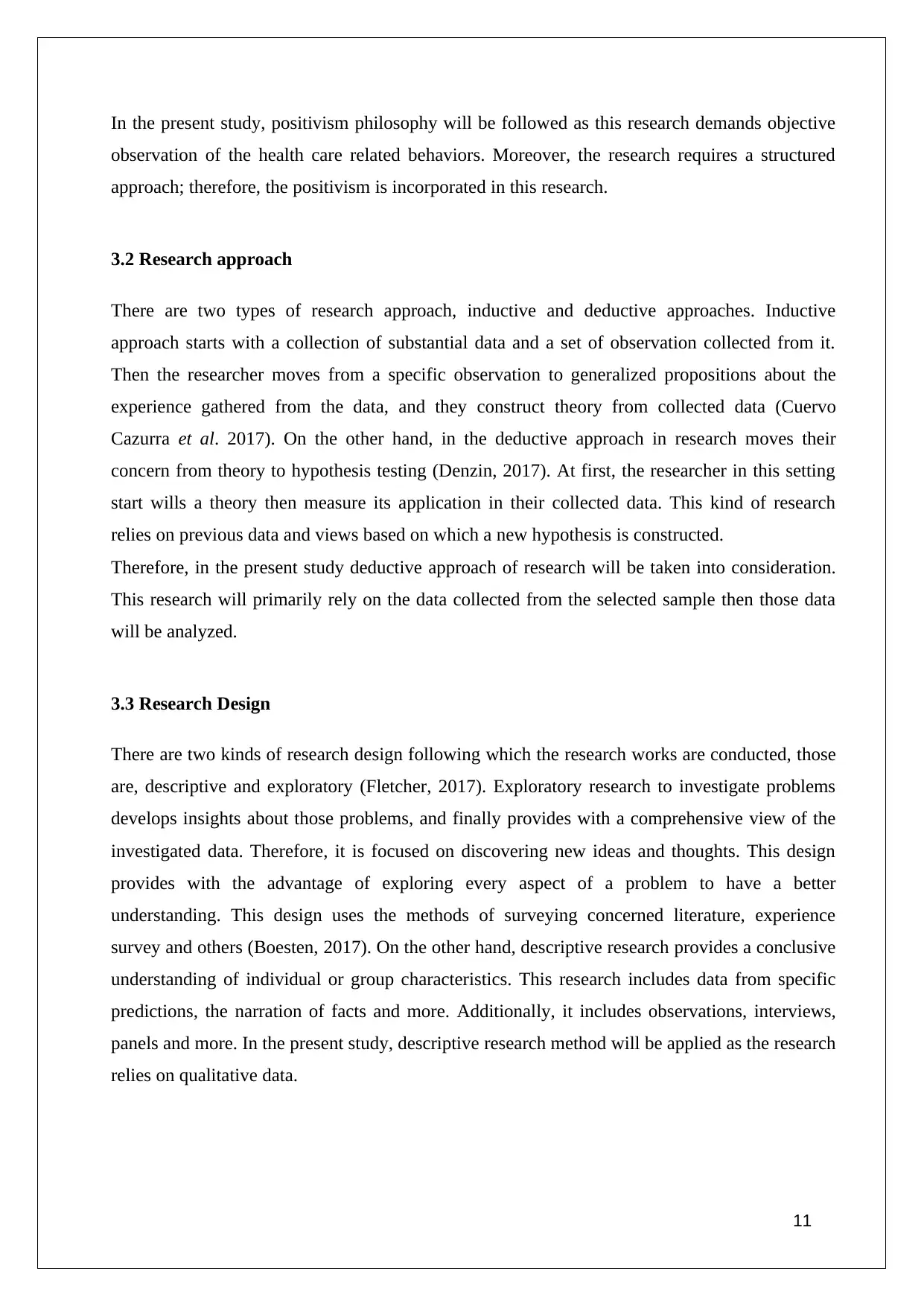
In the present study, positivism philosophy will be followed as this research demands objective
observation of the health care related behaviors. Moreover, the research requires a structured
approach; therefore, the positivism is incorporated in this research.
3.2 Research approach
There are two types of research approach, inductive and deductive approaches. Inductive
approach starts with a collection of substantial data and a set of observation collected from it.
Then the researcher moves from a specific observation to generalized propositions about the
experience gathered from the data, and they construct theory from collected data (Cuervo
Cazurra et al. 2017). On the other hand, in the deductive approach in research moves their
concern from theory to hypothesis testing (Denzin, 2017). At first, the researcher in this setting
start wills a theory then measure its application in their collected data. This kind of research
relies on previous data and views based on which a new hypothesis is constructed.
Therefore, in the present study deductive approach of research will be taken into consideration.
This research will primarily rely on the data collected from the selected sample then those data
will be analyzed.
3.3 Research Design
There are two kinds of research design following which the research works are conducted, those
are, descriptive and exploratory (Fletcher, 2017). Exploratory research to investigate problems
develops insights about those problems, and finally provides with a comprehensive view of the
investigated data. Therefore, it is focused on discovering new ideas and thoughts. This design
provides with the advantage of exploring every aspect of a problem to have a better
understanding. This design uses the methods of surveying concerned literature, experience
survey and others (Boesten, 2017). On the other hand, descriptive research provides a conclusive
understanding of individual or group characteristics. This research includes data from specific
predictions, the narration of facts and more. Additionally, it includes observations, interviews,
panels and more. In the present study, descriptive research method will be applied as the research
relies on qualitative data.
11
observation of the health care related behaviors. Moreover, the research requires a structured
approach; therefore, the positivism is incorporated in this research.
3.2 Research approach
There are two types of research approach, inductive and deductive approaches. Inductive
approach starts with a collection of substantial data and a set of observation collected from it.
Then the researcher moves from a specific observation to generalized propositions about the
experience gathered from the data, and they construct theory from collected data (Cuervo
Cazurra et al. 2017). On the other hand, in the deductive approach in research moves their
concern from theory to hypothesis testing (Denzin, 2017). At first, the researcher in this setting
start wills a theory then measure its application in their collected data. This kind of research
relies on previous data and views based on which a new hypothesis is constructed.
Therefore, in the present study deductive approach of research will be taken into consideration.
This research will primarily rely on the data collected from the selected sample then those data
will be analyzed.
3.3 Research Design
There are two kinds of research design following which the research works are conducted, those
are, descriptive and exploratory (Fletcher, 2017). Exploratory research to investigate problems
develops insights about those problems, and finally provides with a comprehensive view of the
investigated data. Therefore, it is focused on discovering new ideas and thoughts. This design
provides with the advantage of exploring every aspect of a problem to have a better
understanding. This design uses the methods of surveying concerned literature, experience
survey and others (Boesten, 2017). On the other hand, descriptive research provides a conclusive
understanding of individual or group characteristics. This research includes data from specific
predictions, the narration of facts and more. Additionally, it includes observations, interviews,
panels and more. In the present study, descriptive research method will be applied as the research
relies on qualitative data.
11
⊘ This is a preview!⊘
Do you want full access?
Subscribe today to unlock all pages.

Trusted by 1+ million students worldwide
1 out of 18
Related Documents
Your All-in-One AI-Powered Toolkit for Academic Success.
+13062052269
info@desklib.com
Available 24*7 on WhatsApp / Email
![[object Object]](/_next/static/media/star-bottom.7253800d.svg)
Unlock your academic potential
Copyright © 2020–2025 A2Z Services. All Rights Reserved. Developed and managed by ZUCOL.





